Month: July 2021
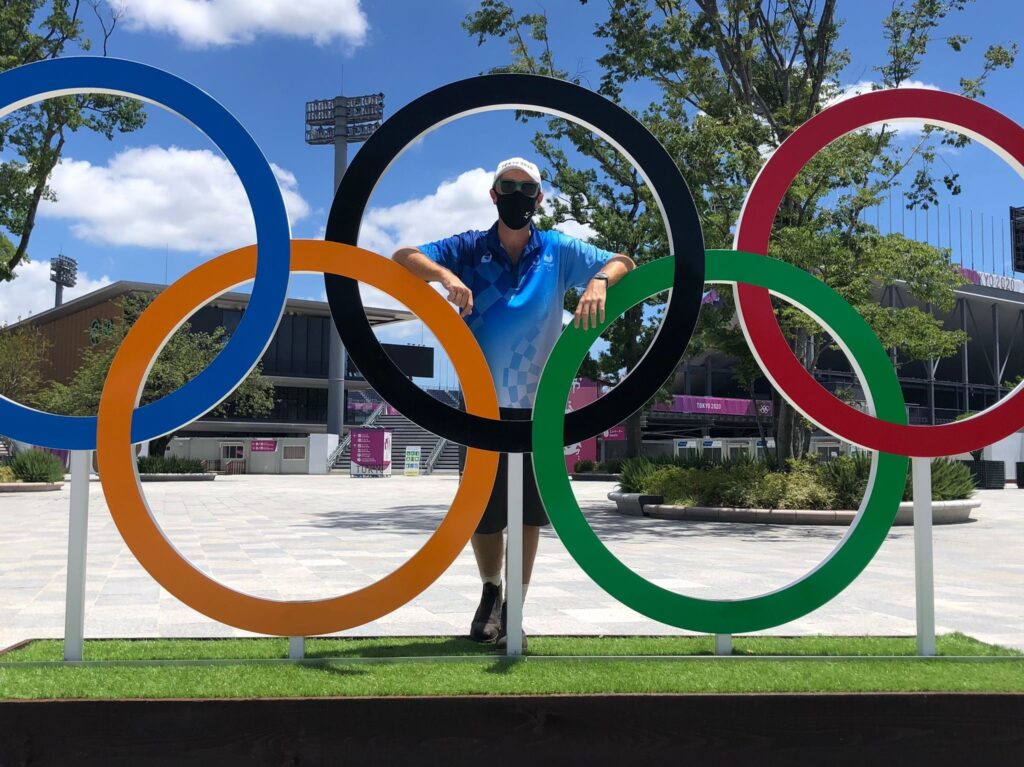
Dr. Christopher Elliott, BVSC, MRCVS, MANZCVS, DACVSMR, is an associate sports medicine veterinarian with Palm Beach Equine Clinic who has served as an FEI Official Veterinarian for elite international events across disciplines. Most notably, he has worked for the 2008 Paralympic Games in Beijing, 2014 World Equestrian Games in Normandy, 2016 Olympic and Paralympic Games in Rio, 2018 World Equestrian Games in Tryon, North Carolina, as well as numerous 3-day events including Sydney, Melbourne, and Adelaide in Australia, and Badminton and Burghley in the United Kingdom. Dr. Elliott has been in Tokyo since early May making preparations for the Olympics as the Veterinary Services Supervisor, and he has given us an inside look into the heat and humidity safety measures for equine athletes.
Tokyo temperatures in July and August can reach as high as 105º Fahrenheit (41º Celsius), so cooling measures are crucial to preventing overheating for all athletes, both equine and human.
Safety measures include:
- Cooling tents have been made easily accessible throughout Equestrian Park. The cooling tents are well stocked with water troughs, which are monitored by a team of volunteers who use ice blocks to keep the water at 59º Fahrenheit (15º Celsius).
- Misting fans in cooling tents are on for the duration of training and competition times.
- Training is halted from 11:00 a.m. until 3:00 p.m. which are the hottest times of the day.

Tokyo Olympics Veterinary Services Supervisor Dr. Christopher Elliott. 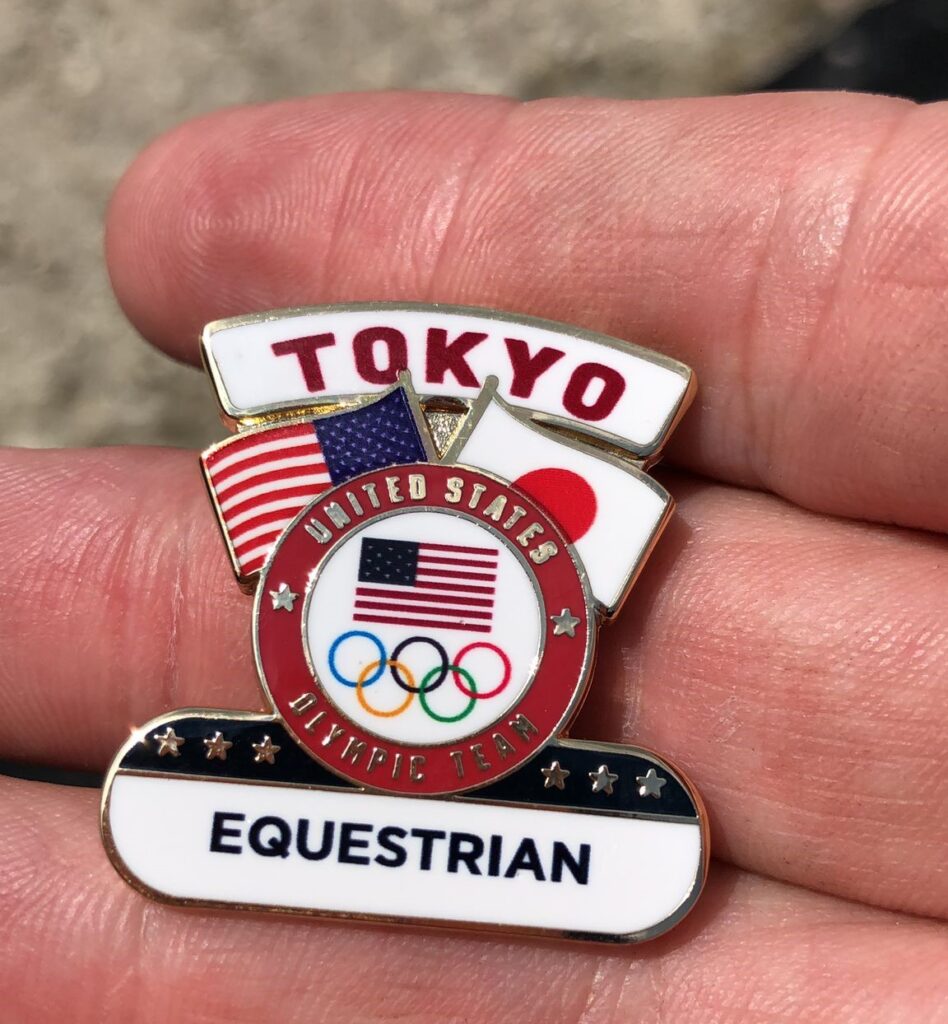

Cooling areas at the end of each barn aisle in the Equestrian Village in Tokyo. 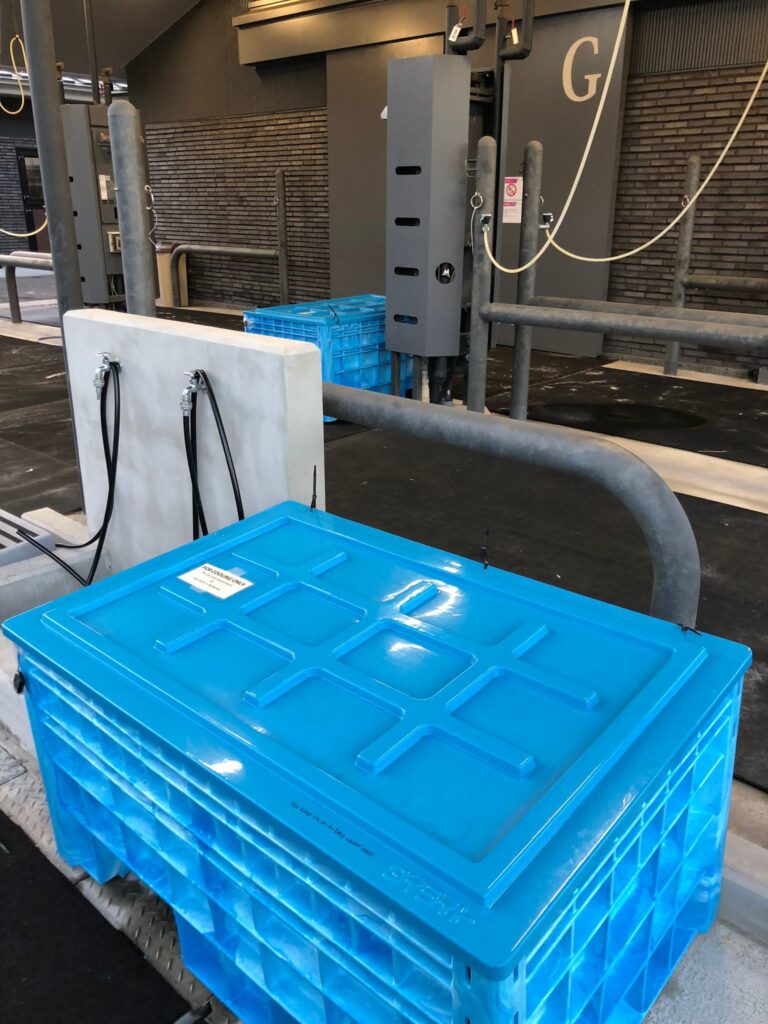
Water troughs have been made available at the ends of each barn aisle and are kept at 59 degrees Fahrenheit. 
Horses touch down in Japan!
This is not the first time extreme heat has caused concern for equestrian athletes at the Olympic Games, and significant research has been conducted to increase athlete safety when temperatures are high. Dr. Elliott published clinical insights regarding research studies between the 1992 Barcelona Olympic Games and the 1996 Atlanta Olympic Games.
Dr. Jorge Gomez to Serve as Official Veterinarian for Mexico Show Jumping Team

Dr. Jorge Gomez, MVZ, MS, DACVS, is the Official Veterinarian for the Mexico Show Jumping Team at the 2020 Olympic Games in Tokyo. Dr. Gomez, originally from Colombia, joined PBEC in 2011 and has since served as an Official Veterinarian at the 2012 Olympic Games in London, the 2014 Alltech FEI World Equestrian Games in Normandy, the 2015 Pan American Games in Toronto, and the 2016 Olympic Games in Rio.
“It is an honor to have been chosen for this responsibility,” said Dr. Gomez. “I have had the fortune of serving in two previous occasions and am grateful for the opportunity to return as a veterinarian for the Olympics.”
There is a tremendous amount of work and attention to detail required in preparing and maintaining an Olympic-caliber equine athlete. Over the past six months, Dr. Gomez has been working closely with the Mexico Show Jumping Team horses and riders. The Team just concluded a European tour, competing in three highly renowned Nations Cup competitions in Rome, Italy, St. Gallen, Switzerland, and La Baule, France. During these events, Dr. Gomez pays very close attention to the horses by examining them each morning, evening, and observing them during training. The horses’ veterinary care and overall health will remain Dr. Gomez’s utmost priority well after the Olympic cauldron is lit as competition begins at the Equestrian Park.

“The Olympic Games bring together the best athletes in the sport. In our case, the best horses and the best riders. It is a wonderful opportunity to be able to watch and learn from the top combinations in the world. For myself, it is also a unique opportunity to share time with fellow team veterinarians from around the world,” said Dr. Gomez.
For updates from Dr. Gomez at Olympic Village, follow Palm Beach Equine Clinic on Instagram @pbequineclinic, Facebook, or Twitter @PalmBeachEquine.
Put Your Best Foot Forward
How to Keep Horses’ Hooves Strong Through Summer
Read this article on The Plaid Horse
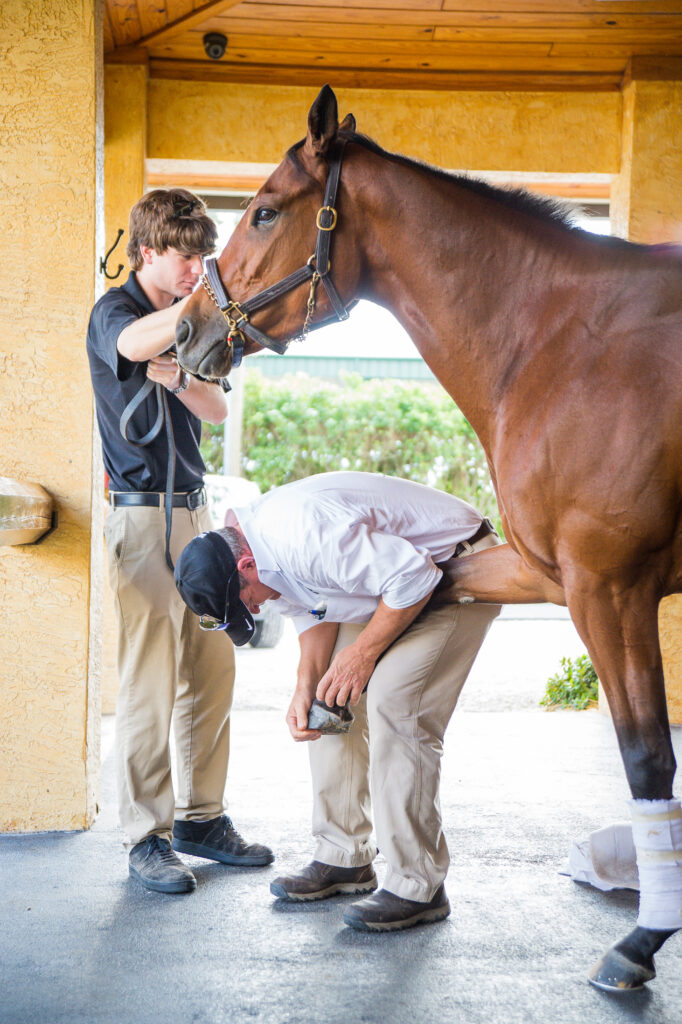
Proper hoof health is hard to achieve any time of year, but during the hot summer months, a solid, healthy hoof is even more difficult to attain due to an increase in moisture in the environment. Each July, the American Farriers Journal dedicates a week of the calendar to recognize farriers for their dedicated commitment to delivering hoof care to horses. To honor our hoof care experts, we spoke with veterinarian and farrier Dr. Stephen O’Grady on how moisture contributes to a weaker hoof infrastructure and offers steps owners and managers can take to help keep moisture away and strengthen horses’ hooves.
Summer can bring scorching temperatures, so we tend to use more water to keep horses cool, both at competitions and at home. In many areas of the country, the humidity levels also increase during this time of year, adding moisture to the air and preventing hooves from drying as quickly. What happens to a hoof with excess water is similar to what would happen to a wooden plank that’s placed in a water trough: it becomes waterlogged, then softens and becomes weaker as a result.
Within a horse’s hoof, there is an exchange of fluids between the outer hoof wall and the inner section of the foot which consists of the bone, blood, and soft tissue structure. This fluid gradient helps keep the hoof wall healthy and promotes overall hoof health. When there is excessive moisture on the outside of the foot, the fluid gradient shifts toward the hoof wall and becomes overloaded with moisture, thus, the foot becomes saturated and the interchange of fluids is no longer effective, affecting a hoof’s mechanical properties.
The lack of flexibility caused by excess moisture creates a softer foot, which ultimately, as the weight of the horse presses down on the hoof, leads to issues such as flattening of the sole, flaring of the hoof wall and hoof wall cracks. A soft foot is also prone to losing shoes, due to its inability to hold nails well. The hoof structure was not designed to withstand as much water as we often subject it to during the summer months. However, there are ways to limit exposure to moisture, even in the hottest temperatures.
It is best to tackle issues that accompany moisture by going straight to the source and minimizing the amount of water that comes in contact with the hooves. This can be accomplished in several ways:
1. Give your horse fewer baths.
Cutting down on how many times per day a horse is hosed can be difficult with competition horses that need to stay clean and that may be exercised, ridden, or shown several times per day. Still, it is important to be strategic about using water, especially on the legs. At home, try to occasionally let your horse air dry in front of the fan if a bath isn’t entirely necessary. Body clipping will help your horse’s heat tolerance this time of year and you may not have to use the hose after every ride.
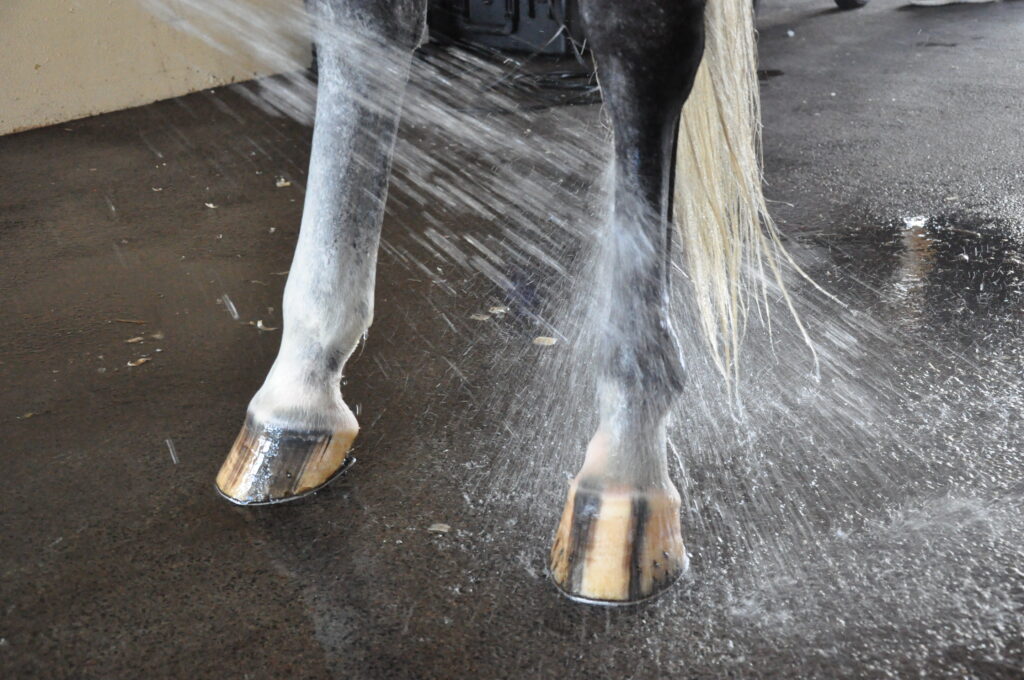
2. Avoid standing water
If you must bathe, be sure the horse isn’t standing in excess water that rises over the hoof capsule. Try to shower off the horse in a dry area so the surface underneath the horse does not contribute to the moisture level. After being bathed, move the horse to a dry surface so their hooves can thoroughly dry.
3. Use hoof shields to direct water away from the hoof.
A good preventative tool to use while hosing is tight-fitting bell boots that cover the hoof and prevent external water from running down onto the hoof. The same effect can be accomplished with a gallon-sized Ziploc bag. Simply cut the bottom of the bag, place the horse’s foot inside, and seal the bag just below the fetlock to prevent excess water from sliding down the hoof.
4. Stand the horse in sawdust.
Sawdust and similar materials have a drying effect on hooves. If hooves become saturated for any reason, let the horse stand in deep sawdust to extract the moisture. Shavings would work also, but sawdust is the most effective for absorbing moisture.
5. A shellac-type hoof dressing product can help prevent the hoof from absorbing too much water if applied before baths or turnout.
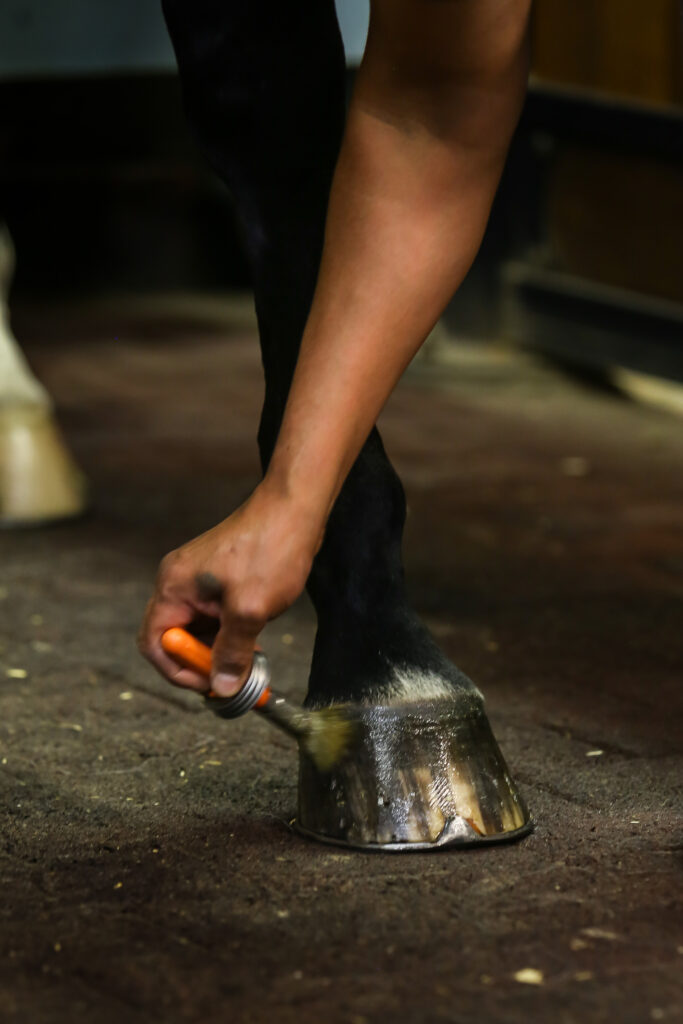
The majority of hoof dressings are intended for this purpose, however. Ask your farrier or veterinarian to recommend options that will do the job when used one to two times per week. Boric acid powder can also be applied to horses’ feet once or twice a week, serving as an astringent for the hoof.
6. Avoid turning out early in the morning.
When humidity is high, the grass at dawn will have a high dew level, meaning horses will be standing on wet surfaces during the first hours spent outside. Though temperatures are cooler as the sun is still rising, for overall hoof health it’s best to wait until the grass has dried.
7. Farriery may need to be changed during the summer months to compensate for the increase in moisture.
Open the lines of communication between veterinarian and farrier. Veterinarians and farriers often do not communicate regarding a particular horse. This is a crucial step to ultimate hoof care. Each professional has a reason behind their decisions, and if the two work together as a team, the horse has a much higher chance of achieving optimal hoof health than if they each operated on their own agenda.

Achieving a healthy hoof is not solely a farrier’s job; it is a whole team effort and requires dedication and attention. By implementing these recommendations into your horse care routine, you can play a role in how moisture affects your horse’s hooves. When considering the effects of excessive moisture on the hoof wall, it’s important to understand there are other factors involved, including the age of horse, breed, genetic makeup, foot conformation, and current farriery practices. With open communication and implementing these measures as a team, you are on the right track to achieving a stronger and overall healthier hoof.